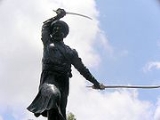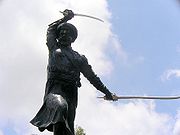
Murarbaji
Encyclopedia

Maratha Empire
The Maratha Empire or the Maratha Confederacy was an Indian imperial power that existed from 1674 to 1818. At its peak, the empire covered much of South Asia, encompassing a territory of over 2.8 million km²....
during the reign of Shivaji. He is best remembered for his defense of the Purandar Fort
Purandar fort
Purandar fort पुरंदर किल्ला figures repeatedly in the rising of Shivaji against the Bijapur kingdom and the Mughals. Purandhar fort stands 4,472 ft. above the sea in the Western Ghats, 20 miles southeast of Pune. It actually consists of two forts - Purandar and Vajragad...
against Diler Khan, a Mughal
Mughal Empire
The Mughal Empire , or Mogul Empire in traditional English usage, was an imperial power from the Indian Subcontinent. The Mughal emperors were descendants of the Timurids...
general who accompanied Mirza Raja Jai Singh
Jai Singh I
Mirza Raja Jai Singh was a senior general of the Mughal Empire and a ruler of the kingdom of Amber . His father was Maha Singh the Raja of Garha, and his mother was Damayanti, a princess of Mewar.The great Raja Man Singh of Amber had several sons, the most capable of whom were the eldest Jagat...
in the 17th-century siege on Purandhar.
Early life
Murarbaji Deshpande was born into a CKP family and his native land was the Javali Satara District. His father was a servant of Chandrarao More. Later, in the service of Chandrarao More of Javali, he moved to Mahad. He fought very bravely against the Bhosales to protect the More's to whom he was loyal. Such braveness was noticed by shivaji maharaj and he thought that murarbaji should be in our swarajya side. He joined the army of Shivaji Maharaj in 1656 after the fall of More Kingdom to Bhosales. He soon became known as the Loyal Sardar of Maharaj and was awarded the title of Killedar of Puranadar.History
The battle for Purandar fortPurandar fort
Purandar fort पुरंदर किल्ला figures repeatedly in the rising of Shivaji against the Bijapur kingdom and the Mughals. Purandhar fort stands 4,472 ft. above the sea in the Western Ghats, 20 miles southeast of Pune. It actually consists of two forts - Purandar and Vajragad...
was a landmark battle of symbolic importance for both the Marathas and Mughals. It was essential for the Marathas to hold off the Mughals for as long as possible, thus demonstrating the difficulty of conquering the mountainous Deccan kingdom. It was equally imperative for the Mughals to conquer Purandhar as swiftly as possible to demonstrate the futility of resistance of the mighty Mughal empire.

Diler Khan, impressed with the bravery of Murarbaji, offered him a truce and employment in the Mughal forces with a handsome salary. Murarbaji turned down the offer due to his loyalty to the ideals of Hindavi Swarajya.He was extremely enraged at this very suggestion and in an act of extreme daredevilry charged with his commandos right into the heart of the Mughal troops,killing hundreds.The remaining Marathas retreated inside the inner walls (baalekilla) of the fort, refusing to surrender and willing to fight to the last man.
The battle of Purandhar showed the Marathas the difficulty in facing the overwhelming force led by Mirza Raja Jai Singh, and revealed to the Mughal the indomitable spirit and tenacity of the Marathas. Thereafter Shivaji agreed to surrender to Mirza Raja rather than risk the decimation of his forces and the ruin of his homeland. As a part of the settlement Shivaji agreed to give up 23 of his forts and 400,000 rupees to the Mughals. He also agreed to let his son Sambhaji become a Mughal Sardar and serve the Mughal court of Aurangzeb. Aurangzeb sought to sign a treaty and invited Shivaji to Delhi rather than face a protracted and expensive campaign to conquer Marathas.

